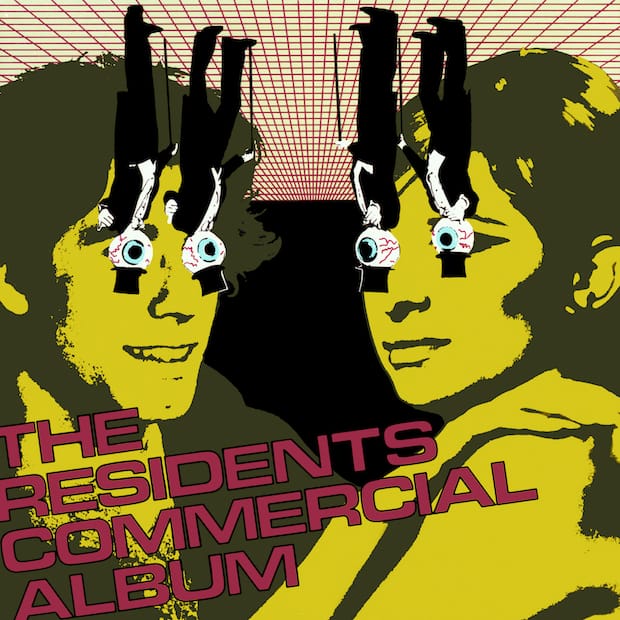Ron Hanson, the editor of Taiwan-based culture magazine White Fungus, talks us through the artwork for The Residents' The Commercial Album – a cover as wild and uncompromising as the band themselves.
Around the time we started White Fungus in 2004, my brother Mark and I were students in Wellington, New Zealand; poor and at the bottom of the world. But we were fortunate in that the city public library had, perhaps surprisingly, a great music collection. Every week we would return to flip through stacks of CDs, borrowing the limit of ten each, at one dollar a disc. Of all our encounters with that multitude of album covers and slices of plastic that lay within, perhaps none was as surprising and immediately stimulating to us as TheCommercial Album (1980), by the Residents, a music group of anonymous identities based in San Francisco that recently celebrated its fortieth anniversary.
The Commercial Album is a collection of forty one-minute songs that the album notes instruct us to repeat three times each to form pop songs. The album pursues faithfully its mantra that contemporary life is entirely advertising, and that pop should merge with the advertising jingle, or at least fully consummate the secretive pact that lies within it. To air The Commercial Album, the Residents purchased forty one-minute advertising slots at San Francisco's top commercial station KFRC, which played the entire record over the course of a weekend, leading to accusations of payola [the illegal payment for airtime] in Billboard Magazine. The group had already demonstrated it was ahead of the curve in its exploration of commercialism as a theme in the 1979 pseudo-ethnographic album Eskimo, in which the Coca Cola slogan “Coca Cola adds life” takes the form of an Inuit chant.
The Residents had courted danger with their album art in Meet the Residents (1974). After selling fifty copies they were threatened with legal action by Capitol Records for appropriating and defacing the cover work for Meet the Beatles. Unchastened, the cover work for The Commercial Album contains montaged images of John Travolta and Barbara Streisand, but with four eye ball-donning pop stand-ins jutting down and masking the eyes of the celebrity cut-outs, heightening the glazed and hollowed look of their stares. As in the music itself, the visual work of the cover brings out the crazed element in pop culture. It is pop as crack cocaine. The Residents bring to the surface a kind of lustful hopelessness in popular culture; the desperation is palpable, as is its ecstatic delirium. The Commercial Album invites us into a catchy but rambling world of verses without choruses and choruses left standing. Its deadpan irreverence and rambunctious musical revelry brings my senses food for thought to this day.
whitefungus.com
White Fungus
This anarchic culture magazine was initiated as a protest against the corporate interests overriding community values – such as the building of an inner-city motorway displaced a community of artists – in Wellington, New Zealand, where the publication was originally based. Initially it was produced quickly on a photocopier, wrapped in Christmas paper and then hurled anonymously through the entrances of local businesses. Since relocating to Taiwan, the magazine similar deals with ideas of consumerism, non-responsive governments, and the lack of non-capitalist spaces for artists to work. White Fungus issue 14 features on Taipei performance artist Dawang Yingfan; interviews with musician Stephen O'Malley and artist Simon Denny and a profile of Wang Fujui, one of the pioneers of Taiwanese noise and digital art.
The Residents
Meet the Residents
wasn’t the only element of the avant-garde band’s output that flirted with the unorthodox. The 1974 album Not Available was recorded with the intension of never being issued and was immediately locked in cold storage once finished. Sadly for the band, but happily for the world, a contractual obligation meant that in 1978 the album was finally released. Just as The Residents enjoyed visual parody, they also were fans of undermining societal and industry conventions using the cover song, releasing a collection of golden oldies in 1976, called Third Reich ’n’ Roll (which a particular inflammatory cover featuring Adolf Hitler and a carrot), and a very successful version of the Rolling Stones’ Satisfaction. Twenty years later, in the mid Nineties, the band took the unusual step of re-releasing their back catalogue on CD-ROM, and even soundtracked CD-ROM game Bad Day on the Midway.

